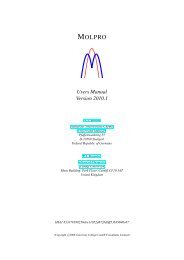Carbon−Carbon Coupling Reactions Catalyzed by Heterogeneous ...
Carbon−Carbon Coupling Reactions Catalyzed by Heterogeneous ...
Carbon−Carbon Coupling Reactions Catalyzed by Heterogeneous ...
You also want an ePaper? Increase the reach of your titles
YUMPU automatically turns print PDFs into web optimized ePapers that Google loves.
<strong>Heterogeneous</strong> Pd <strong>Catalyzed</strong> C−C <strong>Coupling</strong> <strong>Reactions</strong> Chemical Reviews, 2007, Vol. 107, No. 1 139<br />
ally diminished, but the yield was still 89% after the fifth<br />
reuse (Table 7).<br />
Table 7. Reaction of 4-Iodophenol with Phenylboronic Acid<br />
Using Recovered Pd/C as Catalyst<br />
entry Pd/C catalyst yield (%)<br />
1 fresh >99<br />
2 first reuse 95<br />
3 second reuse 94<br />
4 third reuse 90<br />
5 fourth reuse 89<br />
6 fifth reuse 89<br />
Recently, Sajiki et al. reported an efficient protocol 94 for<br />
the phosphine-free Suzuki reaction catalyzed <strong>by</strong> Pd/C at room<br />
temperature. Unlike in the procedure used <strong>by</strong> Köhler et al. 81<br />
(Vide supra), a commercial catalyst was used, and the<br />
reaction could be carried out at room temperature omitting<br />
the need for sealed tubes but needing much higher quantities<br />
of catalyst (10 mol %). Bromoarenes with either electronwithdrawing<br />
substituents, such as NO2, CHO, COCH3, or<br />
CO2C2H5, or electron-donating substituents, such as OCH3,<br />
coupled readily with arylboronic acids in excellent yields<br />
(Table 8) using commercially available 10% Pd/C (3.5 mol<br />
%) in ethanol-H2O (1:1) and Na2CO3. Aryl bromides<br />
containing electron-withdrawing substituents reacted faster<br />
than those with electron-donating substituents (for example,<br />
entry 1 vs entries 2-4).<br />
Table 8. Pd/C-<strong>Catalyzed</strong> Suzuki <strong>Coupling</strong> of Aryl Bromides and<br />
Arylboronic Acids at RT<br />
entry R R′ t (h) yielda (%)<br />
1 OMe H 6 95<br />
2 Ac H 5 99<br />
3<br />
4<br />
NO2<br />
CHO<br />
H<br />
H<br />
2<br />
5<br />
>99<br />
>99<br />
5 Ac 4-OMe 2 97<br />
6 CHO 4-OMe 2 96<br />
7<br />
8<br />
NO2<br />
OMe<br />
4-OMe<br />
4-OMe<br />
1<br />
5<br />
98<br />
>99<br />
9 Ac 3-OMe 3 >99<br />
10 OMe 2-OMe 5 94<br />
11<br />
12<br />
NO2<br />
CHO<br />
2-OMe<br />
2-OMe<br />
4<br />
5<br />
>99<br />
98<br />
13 Ac 2-OMe 4 >99<br />
14<br />
15<br />
NO2<br />
CO2Et<br />
4-Ac<br />
H<br />
19<br />
3<br />
>99<br />
99<br />
a Isolated yield.<br />
The catalyst could be recovered using a simple filtration<br />
and washing sequence. Reuse was possible without significant<br />
decrease in coupling yield even in the fourth run.<br />
Ligand-free Pd/C-catalyzed Suzuki-Miyaura coupling also<br />
tolerates acid groups in the haloarene and in the arylboronic<br />
acid. It was used in the synthesis of biarylacetic acids 21<br />
(Scheme 3). 95<br />
Scheme 3. Synthesis of Biarylacetic Acids <strong>by</strong> Pd/<br />
C-<strong>Catalyzed</strong> Arylation<br />
The Pd/C-mediated synthesis of the diarylcarboxylic acid<br />
24 was implemented on a large scale (2 × 6.3 kg batches)<br />
in a pilot plant (Scheme 4). 31 Similarly, a phenyldiboronate<br />
was coupled twice with 3-iodophthalate under ligand-free<br />
conditions in the presence of Cs2CO3. 96<br />
Scheme 4. Multikilogram-Scale Synthesis of SB-251475<br />
The integrity of the configuration was maintained in the<br />
Pd/C-catalyzed Suzuki coupling of optically active 4-bromomandelic<br />
acids in the presence of Na2CO3 providing<br />
enantiopure 4-arylmandelic acids 26 (Scheme 5). 97 Both,<br />
electron-donating and electron-withdrawing groups were<br />
tolerated in the arylboronic acid.<br />
Scheme 5. <strong>Coupling</strong> of Optically Active 4-Bromomandelic<br />
Acid with Arylboronic Acids<br />
Recently, it was shown that tetraarylborates can be used<br />
in ligand-free Pd/C-catalyzed Suzuki reaction of bromoarenes.<br />
98 Various biaryl carboxylic acids and phenols were<br />
prepared in high yields (Table 9). Again, the catalyst could<br />
be reused several times. For example, coupling of 4-bromobenzoic<br />
acid with sodium tetraphenylborate catalyzed <strong>by</strong><br />
recovered Pd/C provided 88%, 84%, 81%, and 76% yield<br />
in the first to the fourth reuse, respectively.<br />
Bromo- and iodoheteroarenes can also be used in ligandfree<br />
Pd/C-catalyzed Suzuki coupling. Thus the quinoline 30<br />
was obtained with a very low level of residual Pd. Leached<br />
Pd was found in the reaction mixture, which diminished to<br />
less than 4 ppm after completion of the reaction; that is, the<br />
reaction runs <strong>by</strong> homogeneous catalysis (Scheme 6). 87<br />
The Pd/C-catalyzed synthesis of pyrazolylphenylsulfonamides<br />
32 was implemented in 100-mg scale using a Quest<br />
model 210 synthesizer (Scheme 7). 99<br />
5-Aryl-2-furfurals 34 were synthesized <strong>by</strong> Pd/C catalyzed,<br />
ligand-free Suzuki coupling starting from the corresponding<br />
diethyl acetal 33 (Table 10). 100<br />
A strong effect of the halide was found in Pd/C-catalyzed<br />
ligand-free Suzuki cross-coupling of 2-halocycloalkenones<br />
with arylboronic acids. 101 While 2-iodocycloalkenones 35<br />
reacted under mild conditions at 25 °C under air in aqueous<br />
DME (Table 11), the corresponding 2-bromo-2-cyclohexen-<br />
1-one completely failed to undergo Suzuki coupling under<br />
the same conditions. Only extensive decomposition of<br />
starting materials was observed. 101<br />
The coupling of 2-iodo-2-cyclohexen-1-one with phenylboronic<br />
acid was also examined using recovered catalyst. It<br />
was found that the Pd/C catalyst could be reused at least<br />
five runs without affecting the yield (79-85%). The progressive<br />
decrease in the activity could be efficiently balanced<br />
<strong>by</strong> increasing the temperature of the reaction from 25 to 50<br />
°C. 101












![Hetero [6+3] Cycloaddition of Fulvenes with N-Alkylidene Glycine ...](https://img.yumpu.com/35423358/1/190x245/hetero-6-3-cycloaddition-of-fulvenes-with-n-alkylidene-glycine-.jpg?quality=85)




